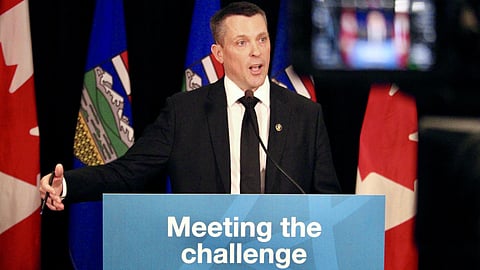

The Government of Alberta tabled its 2025 budget on Thursday, announcing a $5.2 billion deficit for 2025-2026, a projected $2.4 billion deficit for 2026-2027, and a $2 billion deficit for 2027-2028.
"Stormy skies are on the horizon for Alberta’s economy after ending last year on a solid footing," said Finance Minster Nate Horner in budget documents.
"Budget 2025 is taking a cautious approach, reflecting the high risk of a Canada-U.S. trade conflict and broader economic uncertainty stemming from U.S. policy."
The Western Standard asked Horner about Alberta's vast oil and gas reserves and why the province is running a deficit considering its wealth — and is it time to reexamine royalties?
Horner said, "I would say that our royalty structure is legislated — there is a timeline on that. What we have is a very fortunate place where you saw last year — $20 billion in resource royalties, and that allows us to have the tax structure that we have — a very fortunate place."
Horner added, "I think the important thing is using it appropriately. The fiscal rules allow us to not be too reactionary. It gives us time, as long as we manage the surplus as well, we can make appropriate plans when we're in deficit cycles."
"Obviously, we have more uncertainty right now, but our own balance sheet forecasting really is more volatile."
"I think this is a watershed moment for Alberta. We're still trying to catch up and chase the population growth that we've seen, which is a good problem. I would much rather that than decline. But we're going to need to have hard conversations."
As part of the new budget, Alberta is implementing a new 8% personal income tax bracket for incomes up to $60,000, with deployment two years ahead of the schedule.
The tax cut will help Albertans with higher living costs and potential fallout from a Canada-U.S. trade war, said Horner in budget documents..
The new tax bracket will save individuals up to $750 in 2025. Albertans earning less than $60,000 will see their personal income taxes fall by 20%. Overall, the tax cut will save Albertans around $1.2 billion annually in 2025-26.
"While the province is facing increased economic uncertainty and revenue volatility, the government remains committed to making prudent spending decisions to keep operating expense growth below population growth." said Horner.
Alberta's 2025 Capital Plan includes $2.6 billion for new and ongoing school projects, $1.1 billion for family, social supports, and housing, $2.5 billion for roads and bridges, $3.6 billion for health, mental health and addiction, and continuing care facilities, $7.5 billion for municipal infrastructure support, $3.8 billion for capital maintenance and renewal, $1.3 billion for streamlining service delivery, and $0.9 billion for agriculture, natural resources, and business development, among other items.
Total revenue in 2025-26 is forecast at $74.1 billion, a decrease of $6.6 billion from the 2024-25 third quarter forecast of $80.7 billion. The decrease comes mainly from a $4.4 billion drop in oil and gas revenue, driven by an anticipated decline in oil prices.
"Alberta’s economic position as a small, open economy with a large natural resource base makes it uniquely sensitive to global economic and market conditions beyond the province," said Horner in budget documents.
"Fluctuations in global supply and demand can translate into large price swings for Alberta commodity exports and substantial shifts in corporate investment and economic activity."
Alberta's taxpayer-supported debt is now approximately $83 billion at the end of 2025-26 and $98 billion at the end of 2027-28. Debt servicing costs are estimated to be $3 billion in 2025-26.
According to government projections, $2 billion in surplus cash is forecast in 2024-25. The first 50%, or $1 billion, is allocated to the Heritage Fund. The remaining 50% allocated to the Alberta Fund will offset new borrowing requirements in 2025-26.
Legislation allows the province to project a deficit if projected income decreases by $1 billion from the previous year's third quarter forecast, or projected revenue for the fiscal year is less than the previous year's third quarter projected expense.
The Canadian Taxpayers Federation is applauding the Alberta government for giving Albertans a huge income tax cut in Budget 2025, but is strongly warning against its dive into debt by running a deficit.
“Premier Danielle Smith keeping her promise to cut Alberta’s income tax is great news, because it means huge savings for most working families,” said Kris Sims, CTF Alberta Director.
“Families are fighting to afford basics right now, and if they can save more than $1,500 per year thanks to this big tax cut, that would cover a month’s rent or more than a month's worth of groceries.”
“If the government had frozen spending at last year’s budget level, the province could have a $1 billion surplus and still cut the income tax,” said Sims.
“The debt is going up over the next few years, but we caught a lucky break with interest rates dropping this past year, so we aren’t paying as much in interest payments on the debt.”
The province’s debt is now estimated to be $82.8 billion for 2025-26.
Interest payments on the provincial debt are costing taxpayers about $2.9 billion, about a 12 per cent decrease from last year.
The government of Alberta is making the right call by lowering taxes and leaving more money in Albertans’ pockets amidst U.S. tariff threats, according to an Montreal Economic Institute researcher.
“The current trade uncertainties between Canada and the United States are not a government sector crisis, but a private sector crisis, and the Smith government rightly recognizes that,” says Krystle Wittevrongel, director of research at the MEI.
“By lowering Albertan’s tax bills, it is providing much needed relief for consumers and workers who risk bearing the brunt of both countries’ tariff hikes.”
